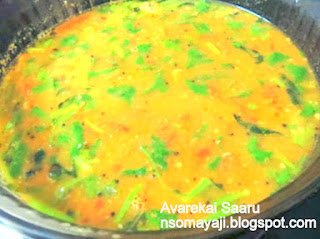Water Melon Rind + Whole Moong Curry is a gravy dish. This curry goes very well with chapatis, rotis, poori, idli, dosa or even akki rotti.
Using water melon rind just came to my mind while we were eating just cut watermelon fruits. When I saw the rind lying in a big bowl, I did not feel like throwing it away. It was so inviting and felt the rind is asking me to cook some thing out of them. They looked so fresh, since it was just cut and it was so crunchy too. So this dish started to develop in my mind. I started to remove the outer thin layer. Half way I was like let me throw it out, next time we can give a try. But still my adamant nature did not allow me throw away the cut pieces. I proceeded cutting in to small pieces. The whole process of chopping these pieces nearly took 10 minutes. But when I looked at the cut pieces it looked marvelous and me the happy chef. Here I am with the recipe of this Water melon rind + Whole Moong Curry or Sambar or Huli as we South Canara people call it.
Now lets see some benefits of using Water Melon Rind and Whole Moong.
Juicy watermelon rinds offer a high dose of cirulline amino acid which helps dilate blood vessels. It helps to improve the blood circulation. It contain some vitamins like Vitamin C and Vitamin B -6. Watermelon rind is good for skin and immunity as well as nervous system.
Whole Moong is rich in Vitamin A, B, C and E. They also contain many minerals including iron, calcium and potassium and its a powerful source of vegetarian protein. It detoxifies the body and benefits the metabolism as well as immune system. Using whole moong helps to lower the high cholesterol level in the blood system, reduces bad cholesterol and improves flexibility of arteries and veins. It also regulates the blood pressure. Green Moong is full of high fibre and it helps in digestion, stabilizes and control the blood sugar.
Here we go with the recipe. It is easy and does not contain lots of oil or fat. I have not used onions or garlic. This curry or sambar goes very well with most of the main dishes like rice or chapati.
Things Needed :
Whole Moong : 1 Cup (Small cup)
Toor Dal : 1 Fist ( 1/3 of the cup you use)
Carrot : 1
Water Melon Rind : 2 to 3 Cups
Coconut : 1/2 Cup
Rasam Powder : 2 Table spoons
Green Chilly : 2
Curry leaves : 5 to 6
Ingh : a pinch
Turmeric powder : a pinch
Tamarind Pulp : 1 Table spoon
Oil : 1/2 Tea spoon
Methi seeds : 4 to 5
Jeera : 1/4 Tea spoon
Salt : To taste
Method :
1. Wash and soak whole moong for 10 minutes in 1/2 a cup of boiling water and cover the lid and leave it for 10 minutes.
2. Wash and cut carrot, curry leaves and green chilly.
3. Remove the outer skin of watermelon rinds and cut it in to small pieces. ( Wash water melon fruit just before you cut them).
4. Now pressure cook Whole Moong, toor dal, carrots and water melon pieces for 6 to 8 minutes and leave it for cooling.
5. Grate coconut and soak tamarind in boiling water for 5 minutes and remove the pulp.
6. Grind coconut with rasam powder till paste and remove the ground mixture from the jar and keep it aside.
7. Keep a big bowl add boiled moong, toor dal and boiled watermelon pieces and carrots.
8. Add tamarind pulp, turmeric powder, salt, required water (1/2 cup) and mix it well.
9. Add ground mixture and boil it nicely for 4 to 5 minutes. Stir in between.
10. Add water if you want the curry to be little liquid and boil for another 3 minutes.
11. Keep a small pan on the fire and heat. Add oil, methi seeds and jeera. Let the methi seeds turn brown. Add ingh and curry leaves. Add this methi jeera fry to the curry.
12. Shift the curry to a serving bowl and serve with hot rice or chapati.
Note :
You can soak Whole Moong for 6 to 8 hours in a normal water and then use it. You better cook watermelon rind pieces in a pressure cooker or it takes longer time to cook if cooked separately. Cooked pieces should be soft to get the best taste of the curry.
You can also use mustard seeds instead of methi seeds. Methi seeds should be used only 3 to 4 or the curry may taste bitter. Adding toor dal is an optional. Adding onions and garlic also an optional. Fry them along methi fry and then add it to the curry. I have used MTR Rasam Powder. You can prepare rasam powder at home by dry roasting 2 table spoons of coriander seeds, 1/2 tea spoon of jeera 5 to 6 methi seeds (1/4 tea spoon), red chilly (5 to 6) . Roast them one by one and then add it with grated coconut to grind.
Time :
Preparation : 10 minutes
Cooking : 30 minutes ( including 10 minutes soaking in boiling water )
Serves : 3 to 4














